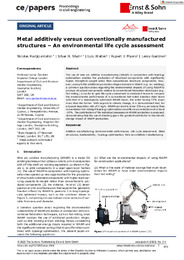| dc.contributor.author | Hadjipantelis, Nicolas | en |
| dc.contributor.author | Shah, Izhar Hussain | en |
| dc.contributor.author | Walter, Lulu | en |
| dc.contributor.author | Myers, Rupert J. | en |
| dc.contributor.author | Gardner, Leroy | en |
| dc.contributor.editor | Jesse, Dirk | en |
| dc.creator | Hadjipantelis, Nicolas | en |
| dc.creator | Shah, Izhar Hussain | en |
| dc.creator | Walter, Lulu | en |
| dc.creator | Myers, Rupert J. | en |
| dc.creator | Gardner, Leroy | en |
| dc.date.accessioned | 2024-01-12T11:04:53Z | |
| dc.date.available | 2024-01-12T11:04:53Z | |
| dc.date.issued | 2023-09-12 | |
| dc.identifier.issn | 2509-7075 | |
| dc.identifier.uri | http://gnosis.library.ucy.ac.cy/handle/7/65962 | en |
| dc.description.abstract | The use of wire arc additive manufacturing (WAAM) in conjunction with topology optimisation enables the production of structural components with significantlyhigher strength-to-weight ratios than conventional structural components. How-ever, owing to the additional production stages involved in WAAM (e.g.arc welding), a commonquestion arises regarding the environmental impacts of using WAAM to produce structural componentsrelative to conventional fabrication techniques (e.g.hot-rolling.) Acradle-to-gate life cycleassessment is conducted herein to compare the environmental performance of a conventional hot-rolled I-section steel beam with that of a topologically optimised WAAM beam,the latter having 53% lower mass than the former.With regards to climate change, it is demonstrated that, for a typical deposition rate of 2 kg/h, WAAM can lead to lower CO2-eq. emissions than conventional hot-rollingiftopology optimisationcan offer mass reductions of at least~50%.The contribution of the individual processes in WAAM production is analysed, demonstrating that the use of shielding gas is the greatest contributor to the climate changeimpact of WAAM production. | en |
| dc.language.iso | eng | en |
| dc.publisher | WILEY | en |
| dc.relation | The research leading to these results has been performed within the ReActiv project, receiving funding from the Eu-ropean Union’s Horizon 2020 Programme (H2020/2014–2020) under grant agreement No. 958208, as well as the European Union’s Horizon 2020 research and innovation programme under grant agreement No. 820776 ‘Intelli-gent data-driven pipeline for the manufacturing of certified metal parts through Direct Energy Deposition process’ (INTEGRADDE). | en |
| dc.rights | Attribution-NonCommercial-NoDerivs 3.0 Greece | * |
| dc.rights | info:eu-repo/semantics/openAccess | en |
| dc.rights | Open Access | en |
| dc.rights.uri | http://creativecommons.org/licenses/by-nc-nd/3.0/gr/ | * |
| dc.source | ce/papers – Proceedings in civil engineering | en |
| dc.source.uri | https://onlinelibrary.wiley.com/doi/10.1002/cepa.2344 | en |
| dc.subject | Additive manufacturing | en |
| dc.subject | Environmental performance | en |
| dc.subject | Life cycle assessment | en |
| dc.subject | Steel structures | en |
| dc.subject | Sustainability | en |
| dc.subject | Topology optimisation | en |
| dc.subject | Wire arc additive manufacturing | en |
| dc.title | Metal additively versus conventionally manufactured structures – An environmental life cycle assessment | en |
| dc.type | info:eu-repo/semantics/conferenceObject | en |
| dc.identifier.doi | 10.1002/cepa.2344 | |
| dc.description.volume | 6 | |
| dc.description.issue | 3-4 | |
| dc.description.startingpage | 672 | |
| dc.description.endingpage | 677 | |
| dc.author.faculty | 007 Πολυτεχνική Σχολή / Faculty of Engineering | |
| dc.author.department | Τμήμα Πολιτικών Μηχανικών και Μηχανικών Περιβάλλοντος / Department of Civil and Environmental Engineering | |
| dc.type.uhtype | Conference Object | en |
| dc.contributor.orcid | Myers, Rupert J. [0000-0001-6097-2088] | |
| dc.contributor.orcid | Hadjipantelis, Nicolas [0000-0001-6368-4962] | |
| dc.contributor.orcid | Gardner, Leroy [0000-0003-0126-6807] | |
| dc.type.subtype | CONFERENCE_PROCEEDINGS | en |
| dc.gnosis.orcid | 0000-0001-6097-2088 | |
| dc.gnosis.orcid | 0000-0001-6368-4962 | |
| dc.gnosis.orcid | 0000-0003-0126-6807 | |


